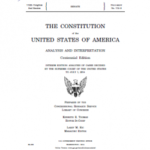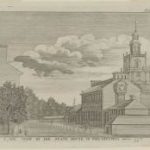When does the First Amendment allow the government to limit speech? Many Americans struggle with understanding the language and subsequent interpretation of the Constitution, especially when it comes to the rights encapsulated in the First Amendment. While many Americans can agree that speech should be protected, there are disagreements over when, where, and how speech should be limited or restricted. This lesson encourages students to examine their own assumptions and to deepen their understanding of current accepted interpretation of speech rights under the First Amendment, including when and where speech is protected and/or limited. It should reinforce the robustness of the First Amendment protections of speech.
The Constitutional Convention: Should Judges Judge Laws?
History is the chronicle of choices made by actors/agents/protagonists in specific contexts. This simulation places students at the Constitutional Convention and asks them to engage with a problematic question: Who should have the final say in deciding whether a law or executive action is constitutional? Students will explore this in theoretical, practical, and political contexts. If one branch has the final say, does that negate the separation of powers? But if no branch has the final say, how are inter-branch disputes to be settled? If unelected justices of the Supreme Court can nullify legislative and executive measures, does that fly in the face of popular sovereignty? On the other hand, if constitutional interpretation is left to “the people,” how might that work, and might that lead to political turmoil?
Equal Justice Under Law
In its first constitutional challenge to the equal protection clause of the Fourteenth Amendment, the U.S. Supreme Court decided to hear a case brought by a Chinese immigrant, not an American citizen. Yick Wo believed city ordinances had been unfairly applied to him, so he challenged their constitutionality under the equal protection clause, and took his case all the way to the Supreme Court.
Grade 9-12 Methods of Interpreting the Constitution
The purpose of this lesson is to explain the two overarching modes of constitutional interpretation, strict and loose construction, and their use and application to particular Supreme Court cases. After an in-class investigation activity to explore the methods of interpretation, students will be given the opportunity to express their opinions of the merits and limitations of each method during a mock Supreme Court session where students will revisit two Supreme Court opinions.
Second Amendment
Students will be able to trace the historic development of the Second Amendment with help from the Common Interpretation in the Interactive Constitution and matters of debate essays, and use evidence from the readings to explore the modern interpretation of the Second Amendment.
The Bill of Rights
In this series of videos, students will hear from constitutional scholars such as Professor Tracey Meares of Yale University, Professor Orin Kerr of George Washington University, Dean Erwin Chemerinsky of Berkeley Law, and Michael McConnell, the director of the Stanford Constitutional Law Center. In these videos, two scholars discuss their interpretations of the amendments, often giving different points of view and interpretations.
Constitution of the United States of America: Analysis and Interpretation

Popularly known as Constitution Annotated, this Senate Document encompasses the U.S. Constitution and analysis and interpretation of it, with in-text annotations of cases decided by the Supreme Court of the United States. What began as an inclusion of the 1911 Senate Manual, is now almost 3,000 pages, and references more than 6,000 Supreme Court cases. The online version is updated regularly as new Supreme Court cases are decided. You can search or browse Constitution Annotated.
The Constitution in Action: Strict vs. Loose Construction
History is the chronicle of choices made by actors/agents/protagonists in specific contexts. This simulation places students in the Early Republic and asks them to engage with questions of Constitutional interpretation faced by President Washington and the First Federal Congress. Did the Constitution empower Congress to charter a national bank? Finance and maintain lighthouses? Regulate working conditions of merchant seamen? Support higher education?
Constitution Primary Source Set
Judicial Independence: Essential, Limited, Controversial
In a constitutional system of government, the role of the judiciary is essential for maintaining the balance of power, protecting individual rights, upholding the rule of law, interpreting the Constitution, and ensuring equal justice for all. In this lesson, students learn about the role of an independent judiciary in the United States.
